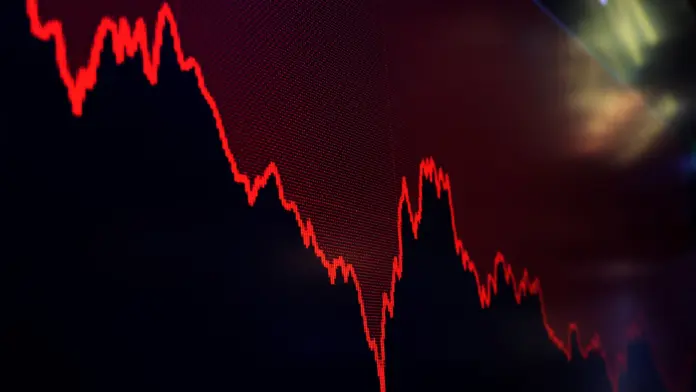U.S. stock futures fell sharply on Monday morning, as investors grappled with the fallout from a G7 summit at the weekend dominated by economic tensions. Dow Jones Industrial Average futures dipped over 600 points, as investors worried further about the incessant trade war and economic uncertainty globally.
Trump’s 90-Day Tariff Delay Fails to Calm Wall Street
The sharp fall in futures comes after President Donald Trump’s revelation of a brief reprieve on scheduled auto tariffs on European imports. While the 90-day reprieve was supposed to leave the door ajar for negotiations, markets interpreted the action as a sign of prolonged uncertainty rather than relief.
U.S. Dollar Index Drops Below 102 as Treasury Yields Slide
The U.S. Dollar Index dropped below the key 102 level on Monday morning, a sign of loss of confidence in the greenback. Meanwhile, the 10-year Treasury yield dropped to 4.45%, as investors sought the refuge of bonds as the stock market experienced volatility. These are signs of growing fears that aggressive rate hikes and trade tensions might take U.S. economic momentum.
Also read: IRS Data Sharing Agreement with ICE Sparks Controversy: Legal, Ethical & Political Fallout
Global Markets Bounce Back Slightly But Sentiment Remains Weak
Asian and European markets attempted a modest comeback after a bumpy week on the back of hopes that delay in U.S. tariffs can ease tensions. The Nikkei 225 gained 0.9% while the STOXX Europe 600 gained 1.1%, although still short of new highs. Analysts warned volatility will continue to dominate unless some more concrete settlement of trade conflict is observed.
Apple Shares Slip as Nasdaq Futures Under Pressure
Apple Inc. fell back in early pre-market trading after a recent rally that was driven by better-than-expected iPhone sales in China. The shares of the tech giant fell 1.2% on early Monday morning, putting extra pressure on falling Nasdaq futures that lost over 250 points.
Fed Stays Cautious Despite Market Calls for Rate Cuts
Despite calls from some investors for the Federal Reserve to signal rate cuts, policymakers remain hesitant. Recent comments from Fed officials suggest a “wait-and-see” approach, with inflation still above the 2% target and labor markets holding steady. Futures markets, however, continue to price in a possible rate cut by the end of the year, especially if economic data weakens.
Global Leaders Welcome Tariff Reprieve as Diplomatic Window Opens
European and Asian leaders welcomed the reprieve of U.S. auto tariffs as a “constructive step” in easing trade tension. EU Trade Commissioner Valdis Dombrovskis said the move creates “a window of opportunity for balanced negotiations.” Japan’s finance minister was also optimistic, describing open lines of communication as being needed to ensure global stability.
Economic Uncertainty Looms Despite Market Bounce
Whereas markets would be expected to grab short-term consolation from worldwide cooperation and diplomatic assurance, overall still, is unsettled. The coming few weeks are “crucial” for the markets, as the analysts of Goldman Sachs noticed, with the time arriving on the inflation figures, retail sales figures, and industrial production. Plus, since there is the earning season impending also, the investors will look sharply for the least sign of tighter monetary policy, as well as geopolitical strain, being faced by corporate America.
Also read: US CPI March 2025 Report: Inflation Cools to 2.4% | Fed Rate Cut Outlook
FAQs
Q1. Why did U.S. dow futures fall sharply on Monday?
A: U.S. stock futures dropped significantly—over 600 points on the Dow—due to growing concerns over global economic tensions and uncertainty following the G7 summit. Investors are reacting to trade war fears and lack of clarity on future tariffs.
Q2. What is the significance of Trump’s 90-day tariff delay?
A: President Trump announced a 90-day moratorium on new auto tariffs on European imports. While intended as a window for negotiations, markets interpreted it as a sign of prolonged trade tension, leading to uncertainty and a market dip.
Q3. How did the U.S. Dollar and Treasury yields react to the news?
A: The U.S. Dollar Index fell below 102, signaling decreased investor confidence. Meanwhile, the 10-year Treasury yield dropped to 4.45% as investors shifted toward safer assets like government bonds.
Q4. How did Apple stock perform amid the market downturn?
A: Apple shares fell 1.2% in early trading despite a previous rally driven by strong iPhone sales in China. The dip added to pressure on tech-heavy indices like the Nasdaq.
Q5. Is the Federal Reserve expected to cut interest rates soon?
A: As of now, the Fed remains cautious. While markets are pricing in a possible rate cut later in the year, Fed officials suggest a “wait-and-see” approach amid persistent inflation and stable labor market data.








